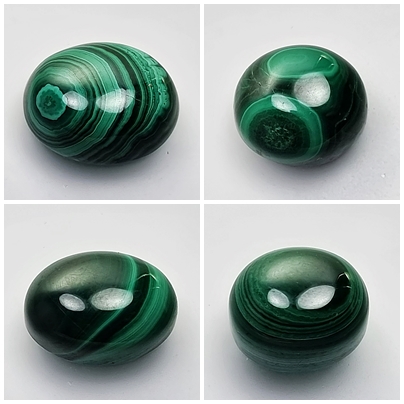Malachite: Gemstone Information
Malachite: Gemstone Information Malachite is Cu2(CO3)(OH)2 and occurs as acicular to prismatic or thick tabular monoclinic crystals but these are too small to be used as ornaments. Botryoidal masses or stalactitic malachite is plentiful. The masses are a deep saturated green and show characteristic banding; the hardness is 3.5–4.5 and there is one direction of perfect cleavage. The SG is usually just over 4 and the RI of the massive material is 1.85.Malachite occurs as a common secondary mineral in the oxidation zone of copper ore deposits and can be an ore of copper.
From the ornamental point of view the most productive deposits include large pure masses formerly (Anthony et al., 2003) from mines around Nizhni Tagil and Ekaterinburg, Ural Mountains, Russia and from various deposits in Africa, including especially mines in Katanga Province, Congo. Crystals from Tsumeb. Namibia. Malachite occurs frequently with azurite (q.v.) and the name azurmalachite has been used for intimate combinations. Pseudomalachite is Cu2 3(PO4)2(OH)4 and is found in association with malachite; it may have been used ornamentally as the hardness is higher than that of malachite at 4.5. Malachite is also found in association with the copper silicate chrysocolla and they may be fashioned together.
Malachite: Unveiling its Mystical Beauty and Healing Properties
Introduction:
Malachite, an enchanting gemstone steeped in history and lore, has captivated the hearts of gem enthusiasts for centuries. With its mesmerizing green hues and swirling patterns, malachite exudes an aura of mystique and sophistication. Beyond its aesthetic appeal, malachite is believed to possess powerful healing properties and spiritual significance. Join us as we delve into the origins, characteristics, and benefits of malachite.
Origin and Composition:
Malachite derives its name from the Greek word “malache,” meaning “mallow,” due to its resemblance to the green leaves of the mallow plant. This striking gemstone is a copper carbonate hydroxide mineral, typically forming in the oxidized zone of copper ore deposits. Malachite often occurs in massive form, displaying banded patterns of varying shades of green. Its vivid coloration is attributed to its copper content, while its distinctive banding is the result of its formation in layers.
Characteristics of Malachite:
Color and Appearance: Malachite is renowned for its vibrant green color, ranging from deep forest green to bright emerald green. Its distinctive banding patterns, varying in intensity and complexity, add depth and character to the stone. When polished, malachite exhibits a lustrous sheen, enhancing its visual allure.
Hardness and Durability: On the Mohs scale of mineral hardness, malachite registers between 3.5 and 4, making it relatively soft compared to other gemstones. Despite its softness, malachite is valued for its beauty and uniqueness. However, it requires gentle handling to prevent scratching or damage.
Transparency and Clarity: Malachite is typically opaque, with limited translucency in certain specimens. Its opaque nature enhances the depth and richness of its green color, creating a sense of depth and vibrancy.
Cut and Shape: Malachite is commonly fashioned into cabochons, beads, and carved figurines due to its softness and intricate banding patterns. Artisans often showcase the stone’s natural beauty by incorporating its unique patterns into jewelry and decorative objects.
Benefits and Uses:
Spiritual and Emotional Healing: Malachite is revered for its ability to absorb negative energies and promote emotional healing. It is believed to cleanse and activate the heart chakra, facilitating emotional balance, compassion, and empathy. By releasing stagnant energy and unresolved emotions, malachite empowers individuals to embrace love and forgiveness.
Protection and Grounding: In metaphysical beliefs, malachite is considered a powerful protective stone, shielding the wearer from negative influences and psychic attacks. Its grounding properties anchor the soul to the physical realm, promoting stability, security, and inner strength. Placing malachite in the home or wearing it as jewelry is believed to create a protective barrier against harm and negativity.
Physical Healing Properties: Malachite is associated with various physical healing benefits, particularly in alleviating ailments related to the heart, liver, and digestive system. It is believed to stimulate detoxification and purification processes within the body, promoting overall health and vitality. Additionally, malachite is thought to relieve symptoms of inflammation, arthritis, and muscular pain.
Enhanced Intuition and Insight: Malachite is said to enhance intuition and psychic abilities, making it a valuable tool for spiritual practitioners and seekers. By activating the third eye chakra, malachite heightens awareness and perception, enabling individuals to access deeper insights and spiritual guidance. Meditating with malachite or placing it near the third eye during spiritual practices may enhance intuition and facilitate inner exploration.
Conclusion:
Malachite, with its captivating beauty and profound healing properties, continues to enchant and inspire individuals seeking spiritual growth and emotional well-being. Whether admired for its aesthetic appeal or cherished for its metaphysical significance, this timeless gemstone serves as a reminder of the interconnectedness between the physical, emotional, and spiritual realms. Incorporating malachite into daily rituals, meditation practices, or jewelry collections can infuse life with its transformative energy and profound wisdom.





